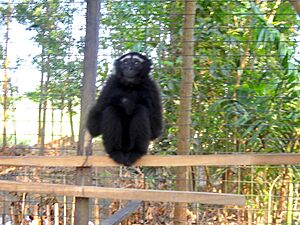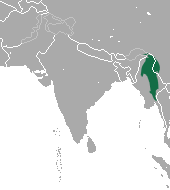Eastern hoolock gibbon facts for kids
Quick facts for kids Eastern hoolock gibbon |
|
|---|---|
 |
|
| Conservation status | |
| Scientific classification | |
| Genus: |
Hoolock
|
| Species: |
leuconedys
|
 |
|
| Eastern hoolock gibbon range | |
The eastern hoolock gibbon (Hoolock leuconedys) is a type of primate. It belongs to the gibbon family, called Hylobatidae. This gibbon is one of three kinds of hoolock gibbon. You can find them in areas east of the Chindwin River in Myanmar. They also live in the southwest part of Yunnan in China. Recent studies show they are not found in India, as was once thought.
Contents
Meet the Eastern Hoolock Gibbon
Eastern hoolock gibbons are amazing apes known for their long arms. They swing through trees with ease. They are an important part of the forest ecosystem. Learning about them helps us understand how to protect them.
What's in a Name?
Scientists once thought hoolock gibbons belonged to a different group. But later, researchers like Mootnick and Groves decided they needed their own special group. They created a new genus called Hoolock. They also realized there were two main types of hoolock gibbons. These were the western hoolock gibbon and the eastern hoolock gibbon. Sometimes, these two types might live near each other. They might even have babies together.
Where They Live and What They Eat
Eastern hoolock gibbons live in forests. They need trees with lots of branches close together. This helps them move around safely. They can live in different kinds of forests. These include forests where trees lose their leaves or stay green all year. They can even be found high up in mountains, sometimes as high as 2,700 meters! These gibbons prefer places with monsoon rains and cool, dry winters.
These gibbons eat many different things. They are omnivorous, meaning they eat both plants and animals. Most of their diet, about 65%, is fruit. They especially love figs. They also munch on lichens, tiny bugs, bird eggs, and parts of plants like buds, leaves, and flowers. What they eat can change based on where they live. It also depends on what food is easiest to find. But fruit is always their favorite.
Gibbon families sleep in tall trees. They pick trees that are close to each other. They often choose trees on hilltops or slopes. When they sleep, they curl up in a ball. They hug their knees to their chests. Gibbons are more active in the summer. They wake up earlier than in winter. They spend about 8 to 10 hours a day awake. During this time, they play and socialize. They go to sleep just before it gets dark. Sometimes, they compete with squirrels for food. They might chase squirrels away from their favorite fruit trees. But other birds, like thrushes and magpies, might try to steal their food.
Dangers They Face
The biggest danger to eastern hoolock gibbons is losing their homes. Human activities cause this habitat loss. Things like cutting down trees for wood, mining, building new areas, and farming destroy their forests. Some gibbons have also been hunted by people for food or for traditional medicine.
In Myanmar, a big problem is commercial logging. This is when many trees are cut down to sell. Gibbons also have to compete with humans for resources in places like the Hukaung Valley Tiger Reserve. Young gibbons can be hunted by monitor lizards (Varanus) and mountain hawk-eagles (Nisaetus nipalensis). Larger gibbons can be attacked by dogs from nearby villages. This happens when they try to cross open areas between forests. Other animals that hunt gibbons include leopards, pythons, and vultures.
Helping Them Survive
Many groups are working to protect these gibbons. In China, there are special places called nature reserves. These include the Gaoligongshan and Tongbiguan National Nature Reserve. Small groups of eastern hoolock gibbons live safely in these areas. In Myanmar, the Mahamyaing Sanctuary helps protect gibbons. The Hukaung Valley Tiger Reserve also has some gibbons living within its borders.
In India, the Forest Department is working with the Wildlife Trust of India. They are moving gibbon families to the Mehao Wildlife Sanctuary. The Biological Park of Itanagar has a program to breed these gibbons. They hope to release them back into the wild. This program works with the Central Zoo Authority. India has also made it illegal to kill or capture eastern hoolock gibbons. However, it can be hard to enforce these laws. So, India often focuses on protecting larger animals first.


